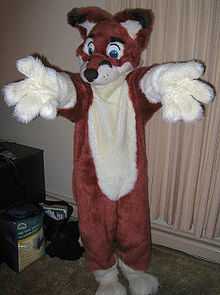Fake fur




Fake fur, also called fun fur or faux fur, is any material made of synthetic fibers designed to resemble fur, normally as part of a piece of clothing. It was first introduced in 1929[1] and has been commercially available since the 1950s, but its increasing popularity has been credited to its promotion by animal rights and animal welfare organizations which claim that it is an animal-friendly alternative to traditional fur clothing.[2]
Uses
Faux fur is not only used in clothing, but also for stuffed animals, fashion accessory and home decorations like pillows, bedding and throws. It is also sometimes used for craft projects because it can be sewn on a sewing machine. Real fur is generally thicker and requires a special machine, hand sewing or an awl to sew it.[3] Lately, fake fur has been increasingly used in the mainstream teen fashion, for example the stores Abercrombie & Fitch[4] and American Eagle[5] use it for trapper hats and jackets. In the Soviet, and now Russian Army, fish fur is used as a slang term for the fake fur used on winter clothing and the ubiquitous ushanka hats. Similarly, fashion design labels such as Ralph Lauren and Chanel have promoted the use of fake fur in their collections.[6]
Advantages and disadvantages
Advantages
- Fake fur is not an animal-use product.
- Fake fur is a fabric and therefore is relatively easy to sew with.
- Fake fur does not require or encourage the breeding of animals in factory farms like real fur.
- Fake fur does not require cold storage to prevent deterioration and is impervious to moths.[7]
- A 1979 study commissioned by the Fund for Animals argued that the energy consumption for the production of one coat made out of fake fur was 120 MBtu, compared to 433 MBtu for trapped animals and 7,965 MBtu for animals raised in fur farms.[8] This study has been criticized as being biased and outdated.[9]
Disadvantages
- Fake fur is not a natural material.[10]
- Fake fur is made from several materials including blends of acrylic and modacrylic polymers derived from coal, air, water, petroleum and limestone. These materials can take a long time to break down, possibly anywhere from 500 to 1,000 years.[9]
- Fake furs are not able to keep snow from melting and re-freezing on the fiber filaments; this is very important, especially in hiking, mountain climbing, skiing and other outdoor activities which are done in extreme conditions.[2]
Use of actual fur
In a test by the Humane Society of the United States, coats labeled as having faux-fur trim used actual fur.[11] In the United States, up until 2012, a labeling loophole allowed any piece of clothing that contains less than US$150 of fur to be labeled without mentioning that it included fur.[11] This is the equivalent of thirty rabbits, three raccoons, three red foxes, three domestic dogs, or one bear.[11]
References
| Wikimedia Commons has media related to Faked furs. |
- ↑ Answers.com. "Fake fur". Retrieved 2009-08-19.
- ↑ 2.0 2.1 "Definition from the Textile and Apparel Industries". Retrieved 2010-01-25.
- ↑ "how to sew torn mink coat?". Retrieved 2009-08-19.
- ↑ "Abercrombie & Fitch | Fur Fleece Sweater - Betsy". Retrieved 2009-08-19.
- ↑ "Women's AE Downtown Bomber - American Eagle Outfitters". Retrieved 2009-08-19.
- ↑ "Search for faux fur on Ralph Lauren site". Retrieved 2009-08-19.
- ↑ "Fur Care: Storage is a must". Retrieved 2009-08-19.
- ↑ "Questions and Answers about Fur" (PDF). The Humane Society of the United States. 1998. p. 2. Retrieved 2008-08-17.
- ↑ 9.0 9.1 "Should I choose fake fur over real fur". Retrieved 2010-03-17.
- ↑ Bekleidungsphysiologisches Institut Hohenstein. "Nothing better than natural fur to keep you warm and comfortable, scientists say". Retrieved 26 November 2010.
- ↑ 11.0 11.1 11.2 Dawn, Karen (2008). Thanking the Monkey: Rethinking the Way We Treat Animals (1st ed ed.). New York City: HarperCollins. p. 110. ISBN 978-0-06-135185-3. Retrieved 12 March 2013.